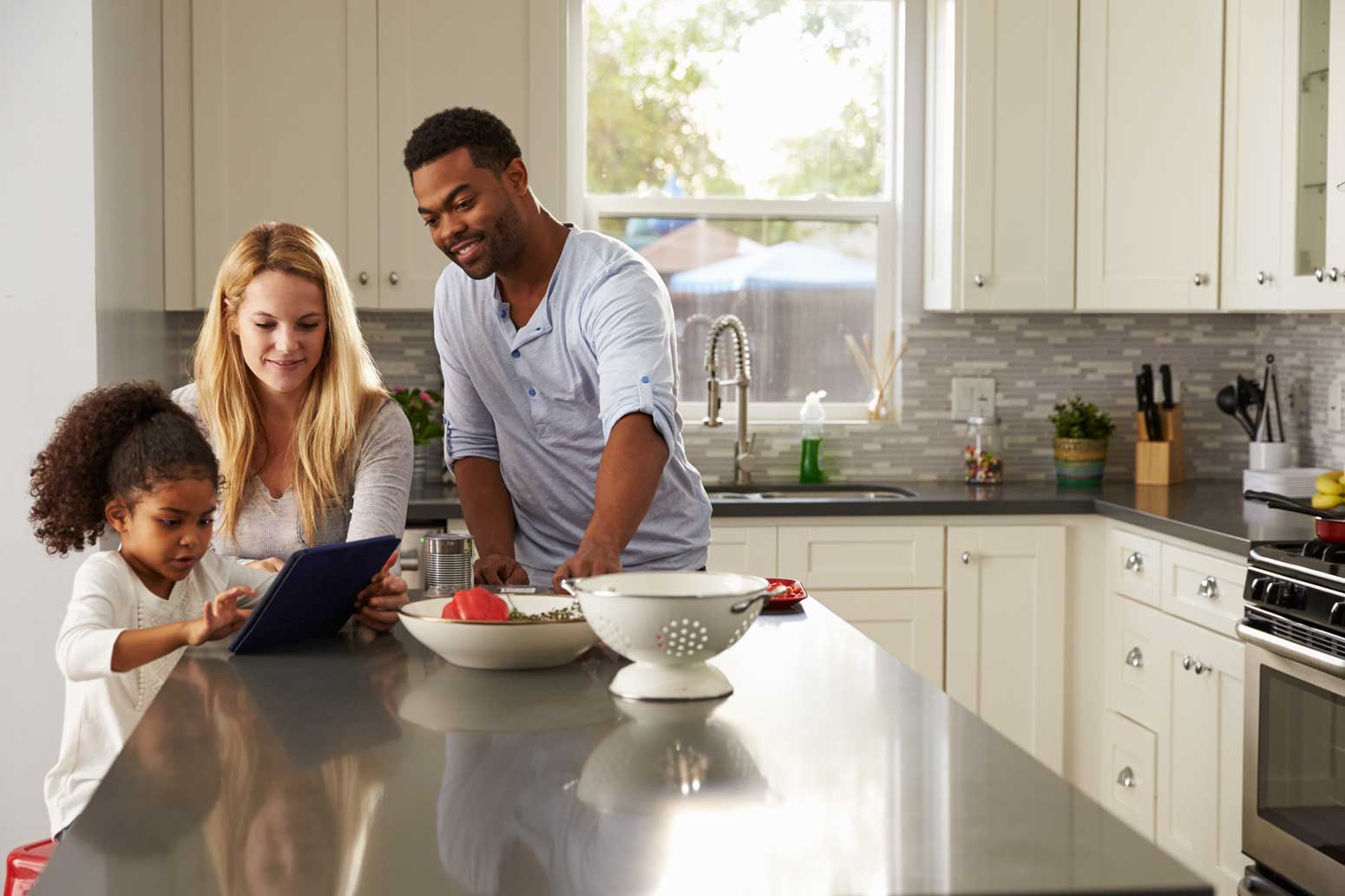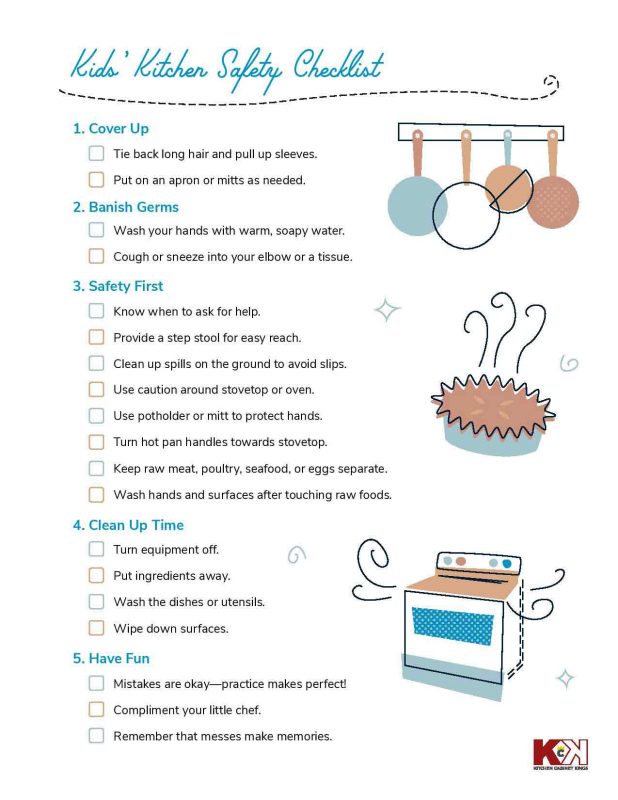How to Get Your Kids Involved in the Kitchen, Safely

As parents, we’re all working on getting our kids away from the screens, and interested in interacting with new and exciting hobbies. It can be hard as a working parent to make time for planning activities, cooking dinner, raising strong kids, and hitting deadlines. By getting your kids involved in cooking early, they’ll be independent quicker, which will save you time down the road.
Teaching your young ones to cook is not only an exciting new outlet, but it’s a skill they’ll use the rest of their lives. By teaching them the proper cooking techniques, they’ll have a jump start on their peers, and you may even get a dinner or two out of it! Before tying up those aprons, print the following kitchen safety checklist (for kids) and explain each item. Hair tied back, hands washed, ingredients put away in respective cabinets, and oven off—for starters!
It’s helpful to plan ahead when deciding what recipe to cook with your kids. Be sure you’re not on a time crunch. You’ll want ample time to relax and explain the process. Kids are curious – especially in the kitchen – so take your time to explain what each step means as you begin.
Ask for Input
Collaborate with your kids when picking out a recipe. Have them help look for ingredients at the grocery store or farmer’s market and help narrow down what ingredients to add for flavor.
Teaching your young ones to cook is not only an exciting new outlet, but it’s a skill they’ll use the rest of their lives.
When you pick out a recipe, consider what your child can do on their own. Put your kids in charge of certain steps, so they are excited to be involved.
If your kid likes to read, they can call out the ingredients or steps of the recipe. Older kids can measure out a half cup of flour, while younger kids can help pour it into the bowl. Prep what you can ahead of time, like setting out tools and ingredients, to help the process go as smoothly as possible.
Younger kids should start out with a simple recipe that has less than five ingredients, while older kids can handle a more challenging recipe. A pizza or taco assembly line is an interactive activity that’s good for any age. Kids can pick out their own ingredients and toppings.
Be Patient
Make sure your kids are well rested and in a good mood when you cook together. This will help avoid frustration if an eggshell happens to slip into the bowl. Allow for messes – you can always clean up later.
Offer guidance if your kids miss a step or make a mistake and explain that it takes time to gain these skills. Remember to compliment your little chef when they conquer a step without your help or whenever it’s appropriate.
Wash Those Hands!

Little hands carry big germs. Explain that clean hands are important for food safety. It helps prevent the spread of gross bacteria to your food and to avoid from getting sick.
As a first step, rolls up your little one’s sleeves and pull back long hair so it doesn’t get in the way. Wash both hands thoroughly with warm soapy water for 20 to 30 seconds. Wear an apron if you’d like to protect your kid’s clothes from spills.
Teach your little chef that raw meat, poultry, seafood, or eggs should be kept separate from other ingredients and to always wash your hands right after touching these foods. To prevent bacteria from spreading, any surfaces used to prepare these foods should be cleaned right after with warm soapy water.
Explain to always cover your mouth and nose with an elbow or tissue if you have to cough or sneeze, so the germs don’t spread to your food.
Hot Surfaces
Safety and supervision are top priorities when cooking with your kids. Consider what tasks are appropriate for your kid’s age and development level. A three-year-old, for example, may not have the motor skills to saute veggies in a hot pan but should be fine to rinse fruit or tear lettuce.
Remind your kids what’s safe and what’s not safe to touch in the kitchen. Burns can happen easily – so use caution near the stove top, oven, and hot pots or pans. Regardless of your child’s age, use supervision if they are in charge of a step that involves heat.
Remind your children to use a potholder or oven mitt to protect their hands when they carry and move hot items. Be sure that a hot pan handle is turned towards the stove top versus facing out to avoid bumping into it.
Practice Knife Safety
It goes without saying that a knife can be dangerous for kids. However, by demonstrating safe knife skills and teaching your kids early on how to handle a knife, they will grow to be more confident.
First, demonstrate to your kids how to hold and use a knife, while explaining how to avoid getting hurt. Be sure your kids have the safety rules down before they practice and use supervision to help them along the way. It’s helpful to start with a sturdy plastic knife and soft foods before graduating to a chef’s knife.
Whether it’s a butter knife or a chef’s knife, explain to always pick a knife up by the handle and point it downwards. There are many ways to hold a knife, similar to how people hold a pencil differently. However, keeping safety in mind for your kids, try one of the following methods.
1. Handle grip: grip the knife so your whole hand is completely on the handle. This grip is comfortable and safe for beginner cooks and little hands.
2. Pointer finger grip: grip the knife with your fist and line your index finger along the top of the knife to keep your hand steady as you chop.
Make sure your kids can clearly see what they’re cutting. The countertop should be at about waist height. Use a step stool if needed.
As you start to practice cutting with your kids, use these helpful guidelines:
- Keep your eyes down at your cutting board to focus.
- Hold the knife firmly with your hand angled up and the knife blade facing down.
- Make sure all fingers are tucked in and out of the way.
- The food you’re cutting should be firmly placed against the cutting board. If you need to move your food, set your knife down flat and away from the edge.
- Be sure the point of the knife stays on the cutting board as you chop. Cut slow and steady with a rocking motion.
Clean Up Time
 Explain to your little ones that clean up is a part of the process and can be just as fun. Come up with a game, like putting ingredients away by color, or play music and dance along as you clean.
Explain to your little ones that clean up is a part of the process and can be just as fun. Come up with a game, like putting ingredients away by color, or play music and dance along as you clean.
Be sure to turn all equipment off. Soak pots or pans in warm soapy water then use a clean sponge or dishcloth to rinse off. If your kids have trouble cleaning large pots or pans, they can help load the dishwasher with smaller dishes and utensils. Wipe down the countertop, stove top, or floor if there are spills. Lastly, put away ingredients where they belong and help your kids if they aren’t sure where things go.
Regularly cooking with your kids is a great way to engage their senses and spend time together in the comfort of your own kitchen. It helps develop motor skills, hand-eye coordination, and life skills they will use as they grow older. They’ll grow to become an adventurous happy eater and eventually be the one cooking you a delicious meal all by themselves.
 —
—
Want to read some more motherhood tips? Start here:
Is Homeschool Right For You? A Few Things to Consider
If Raising a Boy Has You Filled With Fear, You Need to Read This
How to Leave the House with a Family of 5 (60 Quick Steps)
Mom, Do You Believe in Chivalry?
Want to Be a Good Mother? Don’t Smother!
Raising Great Girls: How to Do the Job with Darlene Brock
Don’t miss these popular articles:
It’s OK to Be Assertive and Make Decisions
This Is Why I’m so Glad I Gave up on the “Perfect Body”
5 Great Book Series You’ll Love to Escape Into
When You Feel Alone in Your Beliefs, Try This
How to Crush Comparison With a Compliment
Ask Dr. Zoe – I Love Being a Working Mom, But I Need More Balance!
#gritandgracelife
You’ll love this podcast episode from This Grit and Grace Life: How to Raise Responsible Kids: Tips for Every Age – 087

